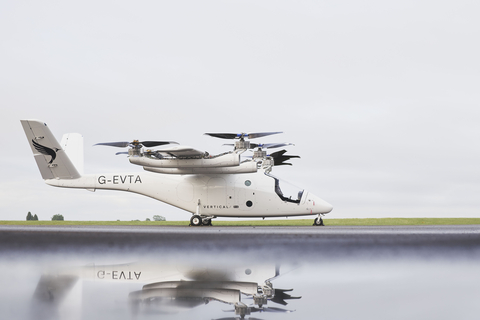Vertical Aerospace Unveils Most Advanced and Powerful Full-scale VX4 Prototype Ahead of Flight Test Programme
- Vertical’s most advanced full-scale prototype is key step towards certification of aircraft.
-
60% of this prototype’s technology is from Vertical’s strategic aerospace partners GKN Aerospace, Hanwha, Honeywell, Leonardo, Molicel, Syensqo. - First use of Vertical’s powerful proprietary battery technology, designed and built in the Vertical Energy Centre, with rapid charging and capable of cruise speeds of up to 150mph.
-
Vertical will shortly begin a robust flight test programme, once the
UK Civil Aviation Authority (CAA) has issued its Permit to Fly.

Vertical Aerospace's new, more advanced VX4 prototype, the only electric take-off and landing vehicle (eVTOL) designed, built and assembled in the
This next-generation VX4 is more powerful than the previous full-scale prototype, with an impressive
The aircraft has been designed and built alongside global aerospace partners, including GKN Aerospace, Honeywell, Hanwha, Molicel, Leonardo and Syensqo. It features Vertical’s next generation propellers and new proprietary battery technology, designed and manufactured at its multi-million pound state-of-the-art Vertical Energy Centre near
The new VX4 prototype has successfully completed systems and aircraft testing and commissioning. Vertical is now working closely with the
Vertical is currently developing an identical full-scale prototype which will accelerate the VX4’s flight test programme and demonstration capability. The company will take flight test learnings from both prototypes into the design and development of the certified VX4 model.
Key new features of the latest full-scale VX4 prototype:
-
Aerospace partner technology and certification expertise –
60% of the technology and components included on the latest aircraft are from world leading aerospace partners, up from10% on the previous prototype. This makes it Vertical’s most advanced prototype yet and a step closer to the aircraft that the company will take through to certification.
- First use of battery designed and built for aviation – This battery and powertrain system, developed at the Vertical Energy Centre, is the most powerful and lightest yet, has rapid charge time and multiple backup power sources. The VX4’s batteries are designed to meet the performance, safety, operational and commercial requirements of eVTOL and it is the first time its own proprietary batteries have been used on a full-scale prototype. The electronics, software and design of the battery have all been developed in house and the new aircraft includes new, more powerful Electronic Propulsion Units.
- Next generation propellers – Vertical’s new proprietary propellers designed specifically for eVTOLs are optimised for low noise and made of carbon fibre composite using a single-shot cure process to maximise integrity. The aerodynamic shape has been specifically designed to maximise performance across both hover and cruise by deconflicting the requirements of each phase of flight.
Stuart Simpson, Chief Executive Officer, Vertical, commented:
“Our goal is to build the safest and most advanced aircraft in this new category of transport. With the new full-scale VX4 prototype, which has been built by combining our own world-leading technology with that from leading aerospace partners, we are well on the way to achieving that goal.
“This is a critical step on our road to certification and commercialisation and, while there is more to do, the support of our partners and our
Dave Stepanek, Executive Vice President, Chief Transformation Officer, Bristow Group:
“As one of the world’s largest helicopter operators, we’re excited to be collaborating with Vertical as they work to bring the VX4 to market. We are delighted to see the progress being made with this latest prototype.”
David Shilliday, Vice President and General Manager, Unmanned Aerial Systems / Urban Air Mobility, Honeywell Aerospace Technologies:
"The VX4 is testament to what can be achieved when industry leaders join forces to pioneer the future of air mobility. This electric aircraft benefits from the Honeywell Anthem flight deck and software, as well as a state-of-the-art fly-by-wire system. This enables the pilot or autopilot to manoeuvre the aircraft safely and simply, ensuring a smooth journey.”
Notes to editors:
About the VX4
The VX4 Type Certification safety target is the same as for commercial airliners and 100 times safer than small single engine helicopters. It is quiet when in cruise - its 50dBA output is lower than normal background noise levels in an urban environment - and has zero operating emissions.
It is designed to be piloted, carry four passengers and has a range of up to 100 miles. The VX4 journey time from Battersea in
Recent Vertical news:
- Vertical recently announced that the scope of its Design Organisation Approval (DOA) has been expanded by the CAA, showing further confidence from the regulator in Vertical’s engineering capability as it progresses towards Type Certification. At the same time, the CAA and European Union Aviation Safety Agency (EASA) have also agreed how they will collaborate on Vertical’s VX4 certification activities.
-
Vertical’s highly skilled Test Team has led a comprehensive programme of system and component testing using the latest technology to ensure our next-generation VX4 prototype is as safe and efficient as possible, including:
- Vertical was one of the first eVTOL companies to carry out a drop test on its battery in 2020, and this latest model is the fifth iteration since the company was formed. Vertical has completed all battery safety testing for the CAA for this latest prototype – crash, thermal runaway, vibration, electronic hardware and software tests, including over 1.2 million hours of cell testing and nearly 3,000 hours of pack and module testing.
- As part of the performance and safety validations for piloted permit to fly approvals with the CAA, Vertical has successfully conducted a spectrum of testing including aerodynamic, noise, static loading, impact and fatigue tests, including nearly 50 million limit-load fatigue cycles on the propeller blades.
- The Vertical Integrated Test Lab (VITL), also known as the 'Iron Bird', conducted 2,700 hours of testing across real aircraft hardware and flight control computers to verify how our proprietary technology performs alongside that of our aerospace partners.
- Thermal, dynamic and endurance performance verification of both our bespoke forward and aft propeller assemblies on our new high-performance Electric Propulsion Units.
- Completed structural tests demonstrating the aircraft structures can sustain the limit load in flight.
Vertical’s leading aerospace partners:
- Honeywell – Vertical is collaborating with Honeywell on the ‘brains’ of the aircraft. It provides flight control computers, avionics and flight control software. The flight control system enables the pilot or autopilot to manoeuvre the aircraft safely and simply, and Honeywell’s Anthem Avionics suite includes the displays and electronic hardware.
- Hanwha - Hanwha Aerospace is Korea’s leading private aerospace company with a broad portfolio ranging from space to jet engines and brings long-established aerospace technology and flight-critical actuator systems expertise. It provides all the VX4 electro-mechanical actuators and mechanisms including tilt and pitch change for the front propellers and aerodynamic control surface actuators.
- Leonardo – As well as being a leading helicopter manufacturer, Leonardo was one of the pioneers in composite fuselage manufacture, making the most complex sections on the Boeing 787. Leonardo has manufactured the composite fuselage and pylons for the VX4 Prototype.
-
Syensqo - Syensqo (formerly
Solvay ) is one of three major aerospace composite manufacturers, their composite material has been used for the VX4 prototypes. - GKN – GKN specialises in composite wings and empennages and has provided Electrical Wiring Interconnection Systems (wiring harness) on all the VX4 prototypes.
- Molicel – Molicel has spent decades developing high performance Lithium-Ion cylindrical cells and its latest P45 battery cell will power the VX4. It is already in mass manufacture, critical for the VX4 to achieve certification.
- Dassault Systèmes - Provides the leading integrated aircraft design software used by all major airframers.
Piloted flight test programme explainer:
- Tethered: the VX4 will perform stabilised hover while loosely tethered to the ground.
- Untethered: the VX4 will hover without a tether.
- Thrustborne: the VX4 will take-off and land vertically and conduct low speed flight manoeuvres with lift generated by the propellers.
- Wingborne: the VX4 will take-off, fly and land like a conventional aircraft, with lift generated by the wing.
- Transition: The VX4 will transition between thrustbourne and wingbourne flight, and vice versa.
About Vertical Aerospace
Vertical Aerospace is a global aerospace and technology company pioneering electric aviation.
Vertical is creating a safer, cleaner and quieter way to travel. Vertical's VX4 is a piloted, four passenger, Electric Vertical Take-Off and Landing (eVTOL) aircraft, with zero operating emissions. Vertical combines partnering with leading aerospace companies, including GKN, Honeywell and Leonardo, with developing its own proprietary battery and propeller technology to develop the world’s most advanced and safest eVTOL.
Vertical has 1,500 pre-orders of the VX4 worth
Vertical's experienced leadership team comes from top tier automotive and aerospace companies such as Rolls-Royce, Airbus, GM and Leonardo. Together they have previously certified and supported over 30 different civil and military aircraft and propulsion systems.
Forward-Looking Statements
This press release contains forward-looking statements within the meaning of the
View source version on businesswire.com: https://www.businesswire.com/news/home/20240717866105/en/
Justin Bates, Head of Communications
justin.bates@vertical-aerospace.com
+44 7878 357 463
Samuel Emden, Head of Investor Affairs
samuel.emden@vertical-aerospace.com
+44 7816 459 904
Source: Vertical Aerospace







